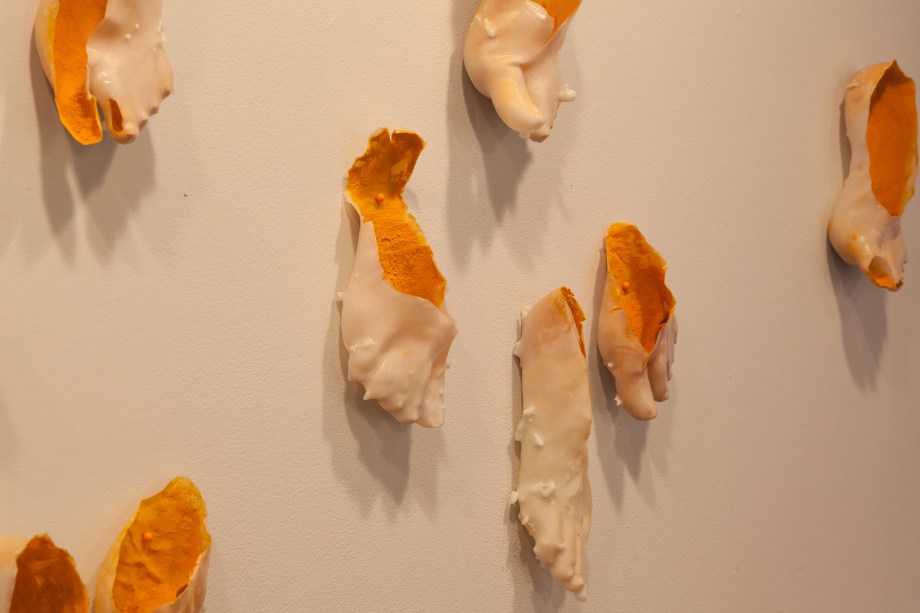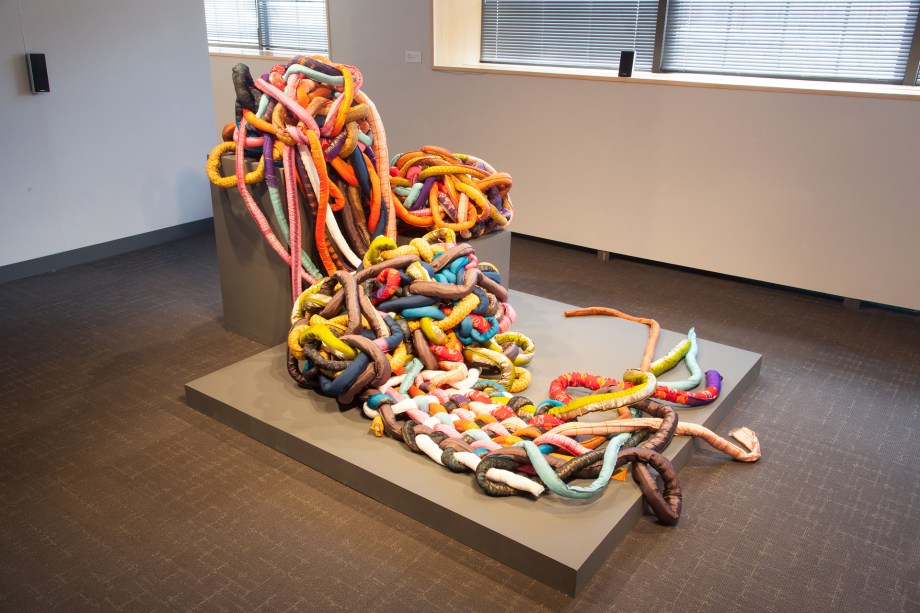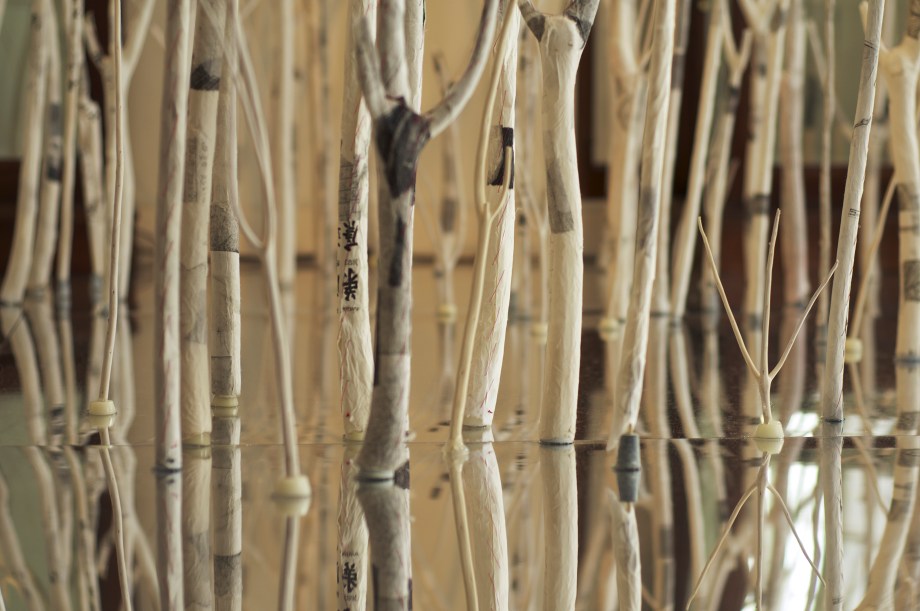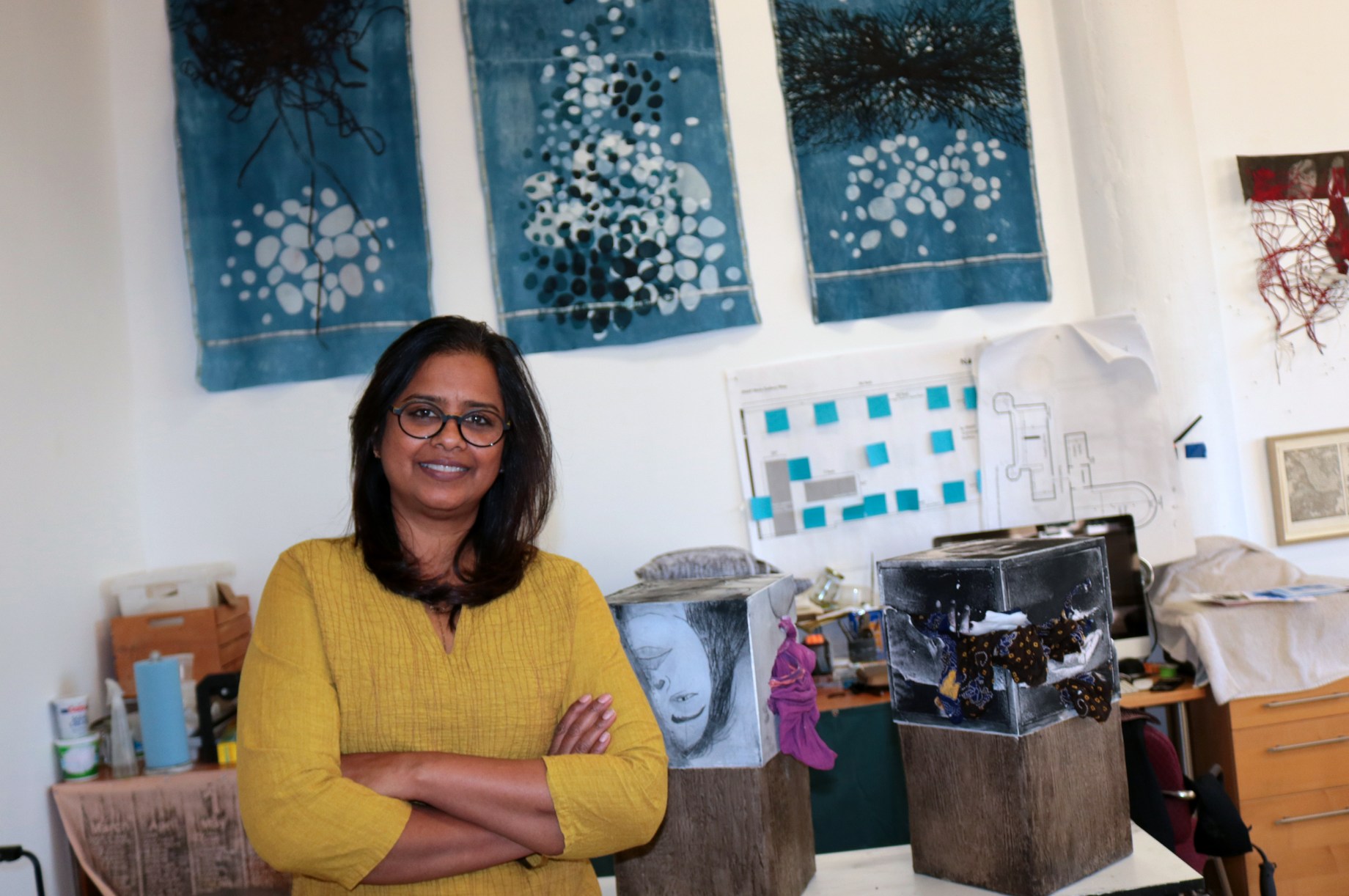Nirmal Raja is an interdisciplinary and conceptual visual artist based in Milwaukee, WI. Her work includes drawing, print, sculpture, installation, and video. Nirmal uses her work to explore identity, memory, and perception of time.
Nirmal periodically curates exhibitions that explore intersectional identity, and provides a platform for underrepresented and global artists. She is a former Mentoring Resident at RedLine Milwaukee, an urban arts incubator, and has upcoming exhibitions at Indiana Green 2018 and Look Here! 2018.
Interview Conducted by Tiffany Chan
Edited by Morgan Moore & Tiffany Chan
Cover image by Sara Risley
| Q: What is your story? How did you fall in love with the visual arts and specifically working in three dimensions? |
| I’ve always been attracted to “making” as a child; even if I didn’t understand till later that this would become what I now call “art”. I appreciated beauty in all its forms, and there was plenty that surrounded me visually…. I grew up making “Rangoli” designs outside my home, crocheting and embroidering with my grandmother, decorating food and sewing garments. These acts of creation still remain part of my art practice. I began to feel acutely the power of time and change as I was experiencing them in my life. I found it hard to represent these abstract notions the way I wanted to in two-dimensional art. Graduate school gave me freedom to think about art beyond a particular discipline. My work became more idea-driven, and anything and everything became my material as long as it served the idea. That was my foray into video and sculpture. If the idea calls for it, I use it. The information technology that is at our fingertips right now makes it possible to teach ourselves many things, in addition to collaborating with experts and fellow artists when my knowledge falls short. |

Size variable, 2016, Flexwax, turmeric powder, map tacks
| Q: What was your professional path like? |
| I grew up in a traditional household in India, and going to art school was not an option. I studied English literature in college, and after coming to this country, studied art between raising two children and many moves. I taught at the University of Wisconsin Milwaukee’s art department for three years, and eventually quit in order to spend more time in the studio. I started exhibiting locally in small group shows and eventually working my way outwards—reaching across the nation and forming connections internationally through friends and mentors. My professional path has been interrupted and has evolved many times due to life changes and will continue to do so… I have learned to embrace this and yet not waver in my practice as artmaking gives me purpose. I can’t think of doing anything else… |
| Q: What is the quirkiest side-job you’ve ever had? |
| Bank teller |
| Q: What does a normal day look like for you? |
| I usually work out, grab breakfast, pack lunch, and walk to the studio which is two blocks away. I keep what you might call “banker’s hours” and head home around 5:00pm, to make dinner and spend time with my husband watching TV or reading… a pretty conventional schedule, I would say. I try not to break up my day with appointments in the middle of the day. It takes me a long time to get into a zone in the studio, and so it helps to have uninterrupted time. I have a studio ritual of making one watercolor painting as soon as I enter. This helps me focus on the task at hand and break through the “ice”. |
| Q: What does your creative process look like? How do you begin? Has your process changed over your career? |
| I like to have focused projects and deadlines. If I do not have a firm deadline or exhibition that I am part of, I create my own parameters. Mostly this starts with brain mapping and writing out a proposal for myself that explores a certain idea that interests me. I start playing with materials that I have accumulated in the studio. Concurrently, I do some reading on subjects that are tied to my idea and also look at what other artists might be making about this concept. I make plenty of mistakes, abandon work, and choose a direction that most excites me. The process needs to be exciting enough for me to work on over an extended period of time and rich enough to not feel like the work is repetitive and simplistic. |

Acrylic mirror, hanji paper, intaglio prints, thread
| Q: What was it like to start your own studio? What were some unexpected challenges/lessons from the process? |
| For many years, my studio was at RedLine Milwaukee, a community arts organization and incubator. This was great, because my studio was surrounded by many other artists’ studios. I utilized the community print shop, swapped techniques, critiques and had interesting conversations with other artists there. Having a studio within a structure like this is also a great way to hold yourself accountable. When you see other artists taking their work seriously, you emulate that as well and contribute towards that strength. Mentoring an artist or two every year was enjoyable, as you develop a close relationship with another artist and have a stake in their success. Now I am in a different studio situation but still part of a larger studio community at Material Studios and Gallery in downtown Milwaukee.
As far as the physical studio is concerned, I would say space is the biggest challenge, and finding that balance between privacy and community. I also think of community as a studio. A major part of existing in a small art community is building relationships with other artists that are nourishing. I have had instances when generosity has not been reciprocated, and I learned to keep my distance from those people. But mostly, I am fortunate to be surrounded by a very supportive community of artists. |
| Q: What is an unexpected skill you’ve had to pick up “on the job”? |
| Speaking in public is hands down the most unexpected skill I have had to learn. I am a shy person, and although I have grown more comfortable speaking in public, it is still a big challenge for me. Writing statements and responses to interviews like this one is also something I didn’t expect to be doing so much. |
| Q: What have been the biggest challenges of being a practicing artist? |
| Getting your work out there to be seen and experienced is every artist’s challenge. Also, the time and talent being valued with money that sustains one’s practice is also an important challenge for most artists. So, I would say visibility and sustainability are the biggest challenges. |

8’ X 12’ X 5’, 2016, Synthetic batting, collected silk saris, wire, thread
| Q: What have been/are the greatest rewards? |
| The greatest reward is that you get to do what you enjoy for a living. It is rare that one can enjoy what they do everyday. It is never boring! |
| Q: What inspires/motivates you? How do you find ways to approach an “old” topic with a new perspective? How do you work yourself out of a creative rut? |
| Having a poetic sensibility towards life helps me be creative. Most of my works comes from personal experience that I then mould into a collective experience through making. I had a huge creative block last year after the elections. I felt like I was frozen, and my work seemed pointless. In the past, my work has never been overtly political and so that work didn’t seem to be relevant anymore. I reached out to other artists and read and listened a lot. This helped me find my voice again.
I tend to have many different projects or what I call “trains of thought” going on at the same time. So, if I get stuck with one, I move on to a different one, and this keeps me moving and exercising my creative muscle. Having a daily ritual in the studio helps me start the day. I make circular or oveloid shaped watercolor paintings every time I come to the studio. It gives me a moment of contemplation and an experience of being in the moment. I have almost a hundred paintings so far, and it will keep growing. I title this collection of work “From the Void”. These quick paintings are playful, freeing, and profound all at the same time. Learning a new technique and trying new materials also inspires me. I love going to artist’s lectures more than opening receptions. It gives me an insight into how other artists think and strategize. I find this really inspiring and it keeps me current. I also read and research areas of interest for each body of work. For example, currently I am making work about history and identity. I am reading about Orientalism and historical representation of race in the West. |

| Q: Your work deals with bicultural identity, memory, and perception— all of which are very personal to your experience. How/when did you know that you wanted to explore these issues in your art? How has your work around those themes changed over time, if at all? |
| Migration is a major factor that influences my work. Change is most drastic and abrupt when your surroundings become memories over and over again. I grew up moving every two to three years due to my father’s job and continued to do so even after I came to America, for one reason or the other. Identity became hyphenated and ever-evolving. I have been compelled to think about change both in me and around me ever since art school.
However, what I make art about has substantially changed over the past year. This is mainly due to political changes in the US. It took me a long time to feel like I belong this country, and the recent rise in xenophobia and increasing polarity in many subjects has left me anxious for the future… I channel this anxiety and try to understand how I fit into this new power dynamic through my work. I coach myself into taking risks I have not taken before by including performance and public visibility in my work. In a recent body of work, I wear each of my barely used saris in public spaces in Milwaukee and collaborate with a local artist and friend Lois Bielefeld to make pictures of this act. This work is about resisting homogeneity and occupying space while being overtly different in appearance and culture. My conversations with Lois led to more work together on our relationship with history. As an immigrant artist entering the timeline of America midway, I am left with a complicated relationship to its history. This has resulted in a performance-based photographic work with Lois and a small group of interested artists in Milwaukee. Both these bodies of work required a lot of courage on my part, as I had never included my physical self in my work before. |

| Q: Were there every moments throughout your career when you doubted yourself/your creative path? How did those moments resolve? |
| I had to suspend my art practice for a stretch of time while my husband and I raised two children. I know that many artist mothers do it well and sometimes have no other choice but to balance the two roles at the same time. But after struggling with that balance, my choice was to take a break and focus on raising children. I was not strong enough to do both to my satisfaction and always felt distracted with one or the other. Over those years, I started to doubt whether I would ever go back to my art practice. It seemed like another universe that I could not imagine navigating. But I knew that there was something in me that needed to be expressed, and I would always be dissatisfied if I didn’t explore that part of me. I took classes for credit wherever we were living at that time. Moore College of Art, Maryland Institute College of Art, etc… This kept me in touch with my skills in the hopes of devoting more time to my practice in the future. Now, both children have left home and I spend each and everyday immersed in art. Time and determination has helped resolve self-doubt and obstacles. |
| Q: There are likely many, but what is a contentious issue in the art world that you really care about? |
| My curatorial practice emerges from a need to provide visibility to under-represented issues and artists and also facilitate a global understanding. I feel like we are cocooned in our “Americanness” and rarely step out of our comfort zone to connect with people different from us. Our politics reflects this in so many ways… these self imposed blinders do us a disservice. We have become homogenous in our visions and aesthetics. Everytime I travel to the coasts or abroad, I am filled with a deep urge to bring that work to Milwaukee to share with the larger community. I like to cross-pollinate, so we can see what others see. |
| Q: Mentorship seems to be something you’ve really prioritized in your career so far; why was this important to you? |
| I was/am very fortunate to have great mentors in my life. I grew up in a culture where wisdom is revered, and so it was natural for me to be attentive to where I can seek it and what to absorb. My professors and a few experienced artists in the community were my mentors and eventually became my friends. I mentor other artists to provide the same kind of support I received. I learn from conversations and research I do with and for my mentees as well. It keeps me engaged in the community, and I find it rewarding. |

Intaglio prints and monotypes on fabric, thread, video projection of shadows
| Q: What is an art incubator and why do we need them? |
| I think of art incubators as visual and conceptual think tanks—a rich and fertile soil to grow in. It is a combination of community, friendship, and mentorship, and I was fortunate to belong to such a place in RedLine Milwaukee for a few years. We need more places like these, especially for new graduates and emerging artists. I firmly believe that good art cannot be made in isolation. We are social animals, and exchange of ideas and aesthetics is crucial to our growth. |
| Q: What advice would you give to your younger self or someone just starting out in the field? |
| Keep pushing. Incremental and steady moves towards your goal are better than giving up in the face of challenges and interruptions. It is indeed a marathon and not a sprint.
Travel far and wide. My most inspiring and humbling experiences come from travel. It gives me a global perspective and brings wonder into my life and art. This is the one thing that can replenish and revitalize a stale and repetitive practice.
Be curious and never stop learning. Learn how to “sift” through knowledge—take in what is most relevant and enriching to you. Always be authentic. Honesty in the work is fundamental. And don’t become “trendy”. Be open to change. And never give up. |
| Q: Some parents may discourage their children from following a creative path, out of concern for financial stability (or at the very least, worry greatly about their children). How would you address those parents/their concerns? |
| I understand the challenge of children wanting to become artists and struggling to convince their parents that it is a viable career path. I myself dealt with it as a young student, when I was not given the freedom to go away to art school, but I also understand why my parents decided to restrict me in such a way.
Although I do not agree with them, their choices were influenced by society, financial concerns, and cultural norms. Being concerned about the success of your children is fundamental to being a parent, and so it is hard for a parent not to worry. I would say if your child simply cannot think of being anything else but an artist and works incredibly hard at it, they are bound to succeed. |

Acrylic mirror, hanji paper, intaglio prints, thread
| Q: What is something you wish the general public knew about artists/the art world? |
| Being an artist is indeed “work”, even if we mostly enjoy what we do. It is not something we do as an escape from reality, but it is about staring reality in the face. It takes courage, honing of skills, and incredible focus and labor. We are the cultural producers, and without us “meaning” is hard to find. |
Just for fun…
| Q: What is your favorite comfort food/drink combination? |
| Dal and rice, South Indian home-cooked everyday food. |
| Q: What do you do for self-care? |
| Walks by the lake and hikes in parks. This always centers me. |
